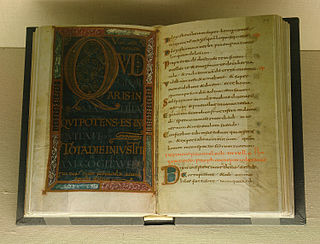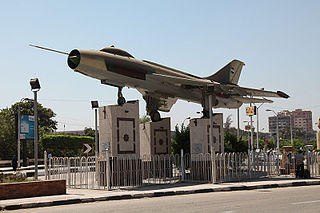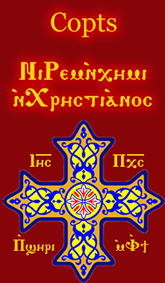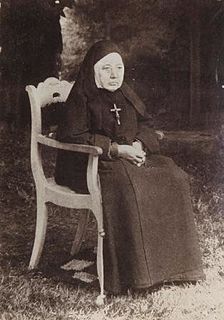Related Research Articles

Anthony or Antony the Great, was a Christian monk from Egypt, revered since his death as a saint. He is distinguished from other saints named Anthony such as Anthony of Padua, by various epithets: Saint Anthony, Anthony of Egypt, Anthony the Abbot, Anthony of the Desert, Anthony the Anchorite, Anthony the Hermit, and Anthony of Thebes. For his importance among the Desert Fathers and to all later Christian monasticism, he is also known as the Father of All Monks. His feast day is celebrated on 17 January among the Orthodox and Catholic churches and on Tobi 22 in the Coptic calendar.

Pachomius, also known as Saint Pachomius the Great, is generally recognized as the founder of Christian cenobitic monasticism. Coptic churches celebrate his feast day on 9 May, and Eastern Orthodox and Roman Catholic churches mark his feast on 15 May or 28 May. In the Lutheran Church, he is remembered as a renewer of the church, along with his contemporary, Anthony of Egypt on January 17.

A psalter is a volume containing the Book of Psalms, often with other devotional material bound in as well, such as a liturgical calendar and litany of the Saints. Until the emergence of the book of hours in the Late Middle Ages, psalters were the books most widely owned by wealthy lay persons. They were commonly used for learning to read. Many Psalters were richly illuminated, and they include some of the most spectacular surviving examples of medieval book art.

Beni Suef is the capital city of the Beni Suef Governorate in Egypt. Beni Suef is the location of Beni Suef University. An important agricultural trade centre on the west bank of the Nile River, the city is located 110 km south of Cairo.

St. Mark's Coptic Orthodox Cathedral is a Coptic church located in the Abbassia District in Cairo, Egypt. The cathedral is the Seat of the Coptic Orthodox Pope. It was built during the time when Pope Cyril VI of Alexandria was Pope of the Coptic Orthodox Church, and was consecrated on June the 3rd 1963.
Samannud is a city (markaz) located in Gharbia Governorate, Egypt. Known in classical antiquity as Sebennytos, Samannud is a historic city that has been inhabited since the Ancient Egyptian period. As of 2019, the population of the markaz of Samannud was estimated to be 410,388, with 83,417 people living in urban areas and 326,971 in rural areas.

The Coptic Orthodox Church of Alexandria has several churches in Great Britain and Ireland under the jurisdiction of four diocesan bishops.

Copts, many of whom are adherents of the Coptic Orthodox Church, began migrating to the United States of America in the late 1940s. After 1952, the rate of Coptic immigration from Egypt to the United States increased. The first Coptic church in the United States, St. Mark's Coptic Orthodox Church, was established in the late 1960s in Jersey City.
The Melitians, sometimes called the Church of the Martyrs, were an early Christian sect in Egypt. They were founded about 306 by Bishop Melitius of Lycopolis and survived as a small group into the eighth century. The point on which they broke with the larger Catholic church was the same as that of the contemporary Donatists in the province of Africa: the ease with which lapsed Christians were received back into communion. The resultant division in the church of Egypt is known as the Melitian schism.

Metropolitan Athanasius (1923–2000) was the Coptic Orthodox bishop of Beni Suef and El-Bahnasa in Egypt from 1962 until his death in 2000. Like Pope Shenouda III, Bishop Athanasius had his roots in the Sunday School movement, a reform movement in the Coptic Orthodox Church of Egypt.

Saint Demiana and the 40 Virgins was a Coptic martyr of the early fourth century.

Angela Truszkowska was a Polish nun who has been beatified by the Roman Catholic Church. Foundress of the Felician Sisters, she forged one of the first active-contemplative communities that, nearly a century and a half later, would grow to include more than 1,800 vowed Sisters over four continents serving in an array of ministries.
Bashmurianrevolts were a series of revolts by the Egyptians in the Bashmur region in the north of the Nile Delta against the Umayyad and Abbasid Caliphates in the eighth and ninth centuries. Exactly how many revolts there were cannot be determined, but the major military conflicts took place in 749, 767 and 831–832.

Aisyiyah is an Islamic non-governmental organization in Indonesia dedicated to female empowerment and charitable work. It was formed on 19 May 1917 by Nyai Ahmad Dahlan to facilitate women's access to education, health care and social services. The organization provides micro-loan and small business development support, family planning services, maternal and pediatric care, orphanages, training for female Muslim clerics, and standard preschool through university level education. These social services end at death, whereby the organization provides female morticians so that female bodies do not need to be prepared for burial by men. Aisyiyah manages several hundred healthcare centers in Indonesia as well as three branches in Egypt, Malaysia and the Netherlands. The organization's stated goal is to make Islamic society a reality for women, and it encourages its members to seek further education even if they become "smarter than their husbands."
Iwannis I was the Patriarch of Antioch and head of the Syriac Orthodox Church from 739/740 until his death in 754/755.
The Enaton was a monastic district in Egypt during the Middle Ages. It lasted into the 15th century, but it was at its height between the 5th and 7th centuries. It takes its name, which means "ninth", from its location at the ninth milestone southwest of Alexandria along the coastal road.
Athanasius of Qus was a Coptic monk, bishop and scholar. He was a leader of the church in Upper Egypt and Lower Nubia. He wrote in both Arabic and Coptic. His works include theology, Coptic grammar and poetry. His primary dialect was Sahidic.
References
- ↑ http://www.britishorthodox.org/103h.shtml [ dead link ]
- ↑ van Doorn-Harder, Pieternella, Contemporary Coptic Nuns (Columbia, S.C.: University of South Carolina Press, 1995) 112.
- ↑ van Doorn-Harder, Pieternella, Contemporary Coptic Nuns (Columbia, S.C.: University of South Carolina Press, 1995) 118.
- ↑ van Doorn-Harder, Pieternella, Contemporary Coptic Nuns (Columbia, S.C.: University of South Carolina Press, 1995) 119.
- ↑ van Doorn-Harder, Pieternella, Contemporary Coptic Nuns (Columbia, S.C.: University of South Carolina Press, 1995) 4.
- ↑ van Doorn-Harder, Pieternella, Contemporary Coptic Nuns (Columbia, S.C.: University of South Carolina Press, 1995) 101.